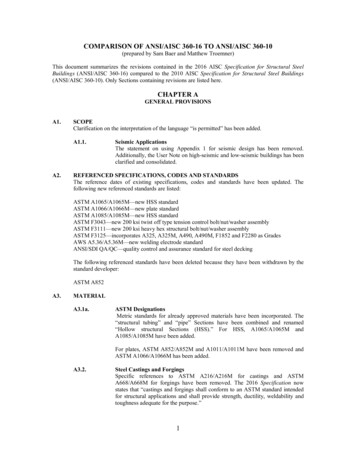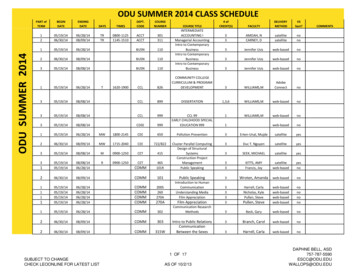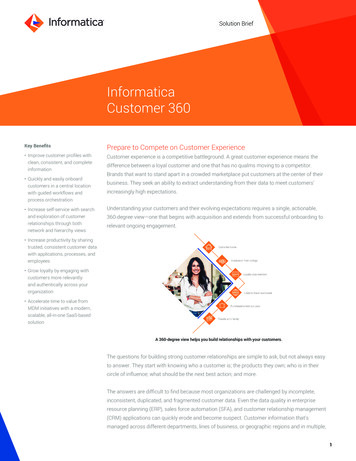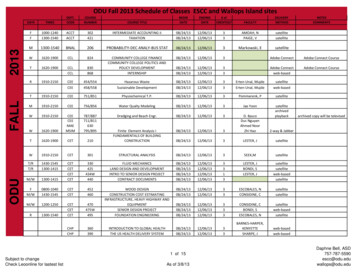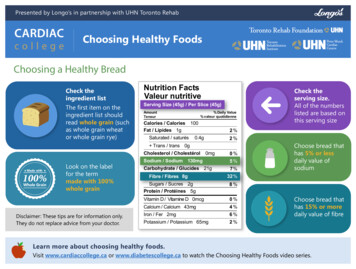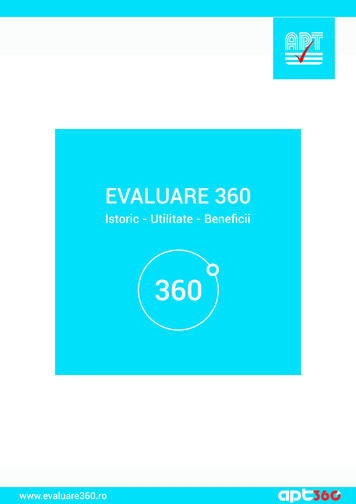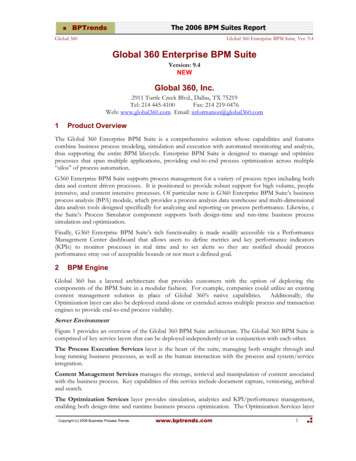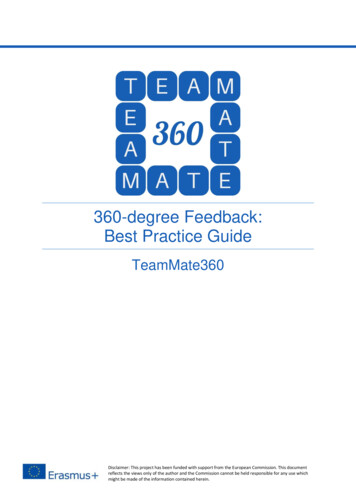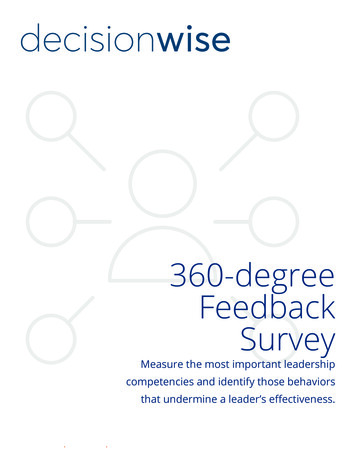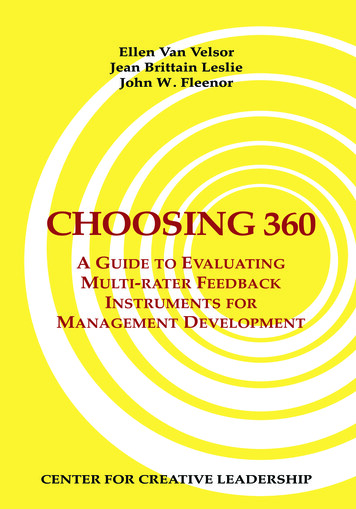
Transcription
Ellen Van VelsorJean Brittain LeslieJohn W . FleenorCHOOSING 360A GUIDE TO EVALUATINGMULTI-RATER FEEDBACKINSTRUMENTS FORMANAGEMENT DEVELOPMENTCENTER FOR CREATIVE LEADERSHIP
CHOOSING 360A GUIDE TO EVALUATINGMULTI-RATER FEEDBACK INSTRUMENTSFORMANAGEMENT DEVELOPMENT
iiChoosing 360
iiiCHOOSING 360A GUIDE TO EVALUATINGMULTI-RATER FEEDBACK INSTRUMENTSFORMANAGEMENT DEVELOPMENTEllen Van VelsorJean Brittain LeslieJohn W. FleenorCenter for Creative LeadershipGreensboro, North Carolina
Choosing 360ivThe Center for Creative Leadership is an international, nonprofit educational institutionfounded in 1970 to advance the understanding, practice, and development of leadershipfor the benefit of society worldwide. As a part of this mission, it publishes books andreports that aim to contribute to a general process of inquiry and understanding in whichideas related to leadership are raised, exchanged, and evaluated. The ideas presented in itspublications are those of the author or authors.The Center thanks you for supporting its work through the purchase of this volume. Ifyou have comments, suggestions, or questions about any CCL Press publication, pleasecontact the Director of Publications at the address given below.Center for Creative LeadershipPost Office Box 26300Greensboro, North Carolina 27438-6300www.ccl.org 1997 Center for Creative LeadershipAll rights reserved. No part of this publication may be reproduced, stored in a retrievalsystem, or transmitted, in any form or by any means, electronic, mechanical, photocopying, recording, or otherwise, without the prior written permission of the publisher. Printedin the United States of America.CCL No. 334Library of Congress Cataloging-in-Publication DataVan Velsor, EllenChoosing 360 : a guide to evaluating multi-rater feedback instruments formanagement development / Ellen Van Velsor, Jean Brittain Leslie, John W. Fleenor.p. cm.Update ed. of: Feedback to managers, vol. 1. 1991.Includes bibliographical references (p. ).ISBN 1-882197-30-51. Organizational effectiveness—Evaluation—Methodology. 2. Feedback(Psychology). 3. Executives—Rating of. I. Leslie, Jean Brittain. II. Fleenor, John W.III. Morrison, Ann M. Feedback to managers. IV. Title.HD58.9.V36 1997658.4'03—dc2197-18853CIP
vTable of ContentsForeword . viiAcknowledgments . ixIntroduction . 1STEP 1: FIND OUT WHAT IS AVAILABLE . 1STEP 2: COLLECT A COMPLETE SET OF MATERIALS . 2STEP 3: COMPARE YOUR INTENDED USE TO INSTRUMENT CHARACTERISTICS . 3STEP 4: EXAMINE THE FEEDBACK SCALES . 4STEP 5: FAMILIARIZE YOURSELF WITH THE INSTRUMENT-DEVELOPMENT PROCESS . 5STEP 6: LEARN HOW ITEMS AND FEEDBACK SCALES WERE DEVELOPED . 6STEP 7: FIND OUT HOW CONSISTENT SCORES TEND TO BE . 9STEP 8: ASSESS BASIC ASPECTS OF VALIDITY—DOES THE INSTRUMENT MEASUREWHAT IT CLAIMS TO MEASURE? . 13STEP 9: THINK ABOUT FACE VALIDITY . 20STEP 10: EXAMINE THE RESPONSE SCALE . 20STEP 11: EVALUATE THE FEEDBACK DISPLAY . 22STEP 12: UNDERSTAND HOW BREAKOUT OF RATER RESPONSES IS HANDLED . 23STEP 13: LEARN WHAT STRATEGIES ARE USED TO FACILITATE INTERPRETATIONSCORES . 24OFSTEP 14: LOOK FOR DEVELOPMENT AND SUPPORT MATERIALS . 28STEP 15: COMPARE COST—VALUE FOR THE PRICE . 31STEP 16: CONSIDER LENGTH A MINOR ISSUE . 32Conclusion . 32References . 33
viChoosing 360Suggested Readings . 34Glossary of Terms . 35Instrument Evaluation Checklist . 39
viiForewordAt the end of 1991, CCL published the two-volume Feedback to Managers (Volume I: A Guide to Evaluating Multi-rater Feedback Instruments;Volume II: A Review and Comparison of Sixteen Multi-rater FeedbackInstruments). Since that time, there has been a notable increase of interest inmulti-rater, or 360-degree, instruments: More are available; they are beingused for a wider range of purposes; and much has been learned about theiruse. A revision is thus in order. What you will find here is an updated editionof the first volume (with a new edition of the second currently in progress).The text has been thoroughly reviewed by the authors—Ellen VanVelsor and Jean Brittain Leslie, who wrote the original edition, and JohnFleenor, who joined the team for this version—and changes have been madeto reflect current understandings in the field—for instance, new informationon the proper use of norms and on “item banks” (a collection of instrumentitems that have been tested for reliability and validity) has been added, andthe section on validity has been redone.You will note that this work has been retitled and that it is no longerreferred to as the first volume of a set. We wanted to make this guide, whichcan help practitioners begin to make sense of the complexity and proliferationof instruments, as visible as possible. The update of the second volume, alsoto be a stand-alone publication, will aid practitioners by providing in-depthdescriptions of selected instruments, including some that were not included inthe previous edition, and discussion of key issues in their use. The two canstill, of course, be used together, and we invite people to do so.Walter W. TornowVice President, Research and Publication
viiiChoosing 360
ixAcknowledgmentsWe would like to express our appreciation to the many reviewers whosecomments, ideas, and criticisms greatly improved the quality of this manuscript. These include David DeVries, Janet Spence, Russ Moxley, MichaelHoppe, Maxine Dalton, Lloyd Bond, and members of the Center for CreativeLeadership’s Writers’ Group. We are also indebted to Clark Wilson, WaltTornow, David Campbell, and Philip Benson for several ideas presented here.
xChoosing 360
1IntroductionMany organizations are using 360-degree-feedback instruments to helptheir managers become better leaders. These instruments are designed tocollect information from different sources (or perspectives) about a targetmanager’s performance. The principal strength of 360-degree-feedbackinstruments is their use of multiple perspectives. In most cases, the differentsources of information (the raters) are the supervisor (or boss), the peers, andthe direct reports of the target manager, although some instruments now allowmanagers to use internal and/or external customers as raters.This report presents a nontechnical, step-by-step process you can use toevaluate any 360-degree-feedback instrument intended for management orleadership development. Although we have simplified this process as much aspossible, it still will require some effort on your part—but effort that will payoff in terms of your having a high-quality instrument that best meets yourneeds.The steps in evaluating a 360-degree-feedback instrument are laid outhere sequentially. Yet all steps are not equal in complexity or importance. Wesuggest that you make the most critical decisions early in the process; in thisway you can save some effort by eliminating instruments that don’t meet yourneeds in terms of content and that don’t pass muster when it comes to reliability and validity.A checklist of the steps is included, for your convenience, at the end ofthis report. There the reader will also find a glossary of many of the technicalwords used here and a list of suggested readings.STEP 1:FIND OUT WHAT IS AVAILABLEThe availability of 360-degree-feedback instruments is increasing at atremendous pace. You can expect that there are as many promising instruments under development as there are good instruments for sale. So your firsttask should be to gain some knowledge of what is out there in order to choosethe best possible sample of instruments to review.In the short run, a good way to familiarize yourself with what is available is to search one of several guides that categorize and review instruments.Feedback to Managers, Volume II (Van Velsor & Leslie, 1991) is one suchguide. It provides basic descriptive and technical data on 360-degreefeedback instruments available for use for management development. Other
2Choosing 360guides include Mental Measurements Yearbook (Conoley & Impara, 1995);Business and Industry Testing: Current Practices and Test Reviews (Hogan &Hogan, 1990); Psychware Sourcebook (Krug, 1993); and Tests: A Comprehensive Reference for Assessment in Psychology, Education and Business(Sweetland & Keyser, 1990). These can usually be found in the referencesection of libraries. Over time, it may be useful as well to keep a file of theinstrument brochures you obtain, because many of the directories are notpublished often enough to keep you updated on the very newest products.STEP 2:COLLECT A COMPLETE SET OF MATERIALSWhen you have identified several instruments you wish to evaluate, youneed to obtain five pieces of information about each of them. You cannotmake an informed decision using only a copy of the instrument or a promotional brochure.Specifically, for each instrument you wish to consider, you shouldobtain the following: A copy of the instrument itself. If the instrument has one form for theindividual to rate himself or herself and a separate form for the otherswho will rate him or her, get both. A sample feedback report (a representation of what the manager willreceive after the instrument is scored). You can’t tell what type offeedback your managers will actually receive by looking at theinstrument they will fill out. The sample could be a complete report,or it could be part of a report such as an example of the feedbackdisplay in the technical or trainer’s manual. Either type will do. A technical manual or other publication that outlines in detail thedevelopmental and psychometric research done on the instrument. Information about any supporting materials that accompany thescored feedback, such as interpretive materials, development guides,goal-planning materials, and the like. Information about price, scoring, and whatever certification or training may be required to purchase or use the instrument.It is not at all unreasonable to request this quantity of information.American Psychological Association guidelines (APA, 1985) require that thisinformation be available upon request when an instrument is offered for sale.In addition to seeking the recommended information, you should,through all the steps that follow, look for evidence of a commitment to
Step 3: Compare Your Intended Use to Instrument Characteristics3continuous improvement on the part of each instrument’s developer. This isespecially true if an instrument has been around for awhile. As we willdiscuss in the section on validity, research should always be in progress,because no instrument can ever be considered valid once and for all. Expectrevisions in the scales over time; these are often made when additionalvalidation studies have been completed. Expect revisions in the presentationof feedback as well; these are often made as the developer learns from theexperience of those who have used an instrument. It is not uncommon forgood instruments to have more than one copyright date, because even smallrevisions to content can cause changes in other areas, such as scaleweightings or instrument norms.STEP 3:COMPARE YOUR INTENDED USE TOINSTRUMENT CHARACTERISTICSIt is improbable that one instrument will meet the needs of all managersin an organization. Job demands differ somewhat by organizational level, andeven at the same management level, skills that are needed for effectivenessmay change over time. In addition, the dimensions on which managers areassessed should be in line with organizational visions for leadership. To theextent that these visions vary across organizations, it is also highly unlikelythat one instrument will meet the needs of all kinds of organizations. Thus, insearching for an instrument to provide feedback to managers, a person istypically looking for one that will satisfy the needs of a particular group ofmanagers in an organization with specific leadership or management needs.Although nearly every 360-degree-feedback instrument has a statementof purpose describing the level of management it targets, there seems to belittle relationship between management level and the domains of activity orbehavior assessed. An instrument targeted toward all levels of managementmight not be right for middle managers in your organization because thecapacities assessed are not in line with company-wide managementdevelopment goals. An instrument targeted toward higher levels might beright for your middle managers if the competencies assessed agree with yourmanagement-development goals.More important than considering the advertised audience is discoveringthe norm group, if any, to which managers will be compared. By norm group,we mean the group of managers whose scores are stored in the vendor’sdatabase and are output as the comparison group on every individual feed-
4Choosing 360back report. If the norm group is comprised of senior-level managers, whoseskills are likely to be more highly developed, the scores of middle managerswill probably appear worse than they would if they were compared to managers similar to themselves. Therefore, look for instruments that have beennormed on a sample similar to your target managers; consider level, organization type, and demographics (for example, ethnicity and gender).But be forewarned: The feedback instruments we are concerned withhere have been developed for use in management-development efforts, eitherin the classroom or in individual feedback settings. These are instruments thathave not been developed or tested for other purposes—such as makingselection or promotion decisions.STEP 4:EXAMINE THE FEEDBACK SCALESIn evaluating individual instruments, you should begin by examiningthe scales on which feedback will be received. Are you comfortable withwhat it measures?There is a detailed discussion of scales in step 6, but what you need toknow at this point is that the scales are made up of several items on theinstrument and represent the content or competencies on which managers willbe evaluated. Each individual scale represents a slice of managerial work (forexample, planning) or a single kind of competency (for example, decisiveness); as a whole the scales provide a portrait of leadership or managerialeffectiveness. Using the sample feedback you have obtained, you shouldconsider the following when looking at the scales: Is your organization wedded to a particular way of representing whatit takes to be effective in your business or do you have a particularmodel underlying management-development efforts? Does the range of scales fit with what you see as relevant competencies for managers in your target group? Does the number of scales seem reasonable? If, in your judgment, an instrument does not have enough scales thatseem relevant to your target group, or if it has too many that seemirrelevant, drop it from further consideration.
5STEP 5:FAMILIARIZE YOURSELF WITH THEINSTRUMENT-DEVELOPMENT PROCESSIn order to know how to identify quality instruments, you must understand the basics of sound instrument development.The development process can be seen as occurring in four stages: developing instrument items and feedback scales,assessing reliability and validity,designing the feedback display, andcreating supporting materials.At each stage different issues are being addressed.When items and scales (fully defined in step 6 below) are being developed, the author must identify, as much as possible, the full range of behaviors or skills that he or she believes represents management or leadershipcompetency. Another question at this stage is whether items of behavior orcompetency cluster in groups that are internally consistent, distinct from eachother, and useful for feedback purposes.To assess reliability, the author of an instrument must consider whetherthe measurement of these skills or competencies is stable in a variety of ways.To assess validity, the author must determine whether the scales reallymeasure the dimensions they were intended to measure and whether they arerelated to effectiveness as a manager or leader. Because 360-degree-feedbackinstruments are primarily intended for individual development, the questionof whether the areas assessed can be developed also must be considered.When designing feedback, the author should try to maximize themanager’s understanding of the data to enhance its impact. In creating supporting materials, the aim of the author is to help the feedback recipient gaindeeper understanding of the theory or research behind the instrument andthereby enhance the ability to interpret and work with the data. Your task asan evaluator is to assess the work completed in each of these four stages andbalance what you find against the needs of your target group.
6Choosing 360STEP 6:LEARN HOW ITEMS AND FEEDBACK SCALES WERE DEVELOPEDInstruments that assess managerial competence or leadership effectiveness are dealing with complicated phenomena. These phenomena cannot beadequately represented by a single behavior or characteristic because they arecomprised of many closely related behaviors and skills. To adequately measure these complex capacities, instruments must have scales that are made upof several items.The process of instrument development typically begins with thewriting of items that represent behaviors or characteristics believed to berelated to effective management or leadership.Items can come from a variety of places. Sometimes the author refers toa theory (leadership theory, theory of managerial work, competency models)to develop specific behavioral statements or statements describing characteristics or skills. At other times researchers create descriptions of characteristicsor skills based on data they have collected. Another way items can be writtenis by basing them on the organizational experience of the author(s). Peoplewho frequently work in training or consulting with managers may feel theycan capture in a set of statements the essence of the leadership or management effectiveness they have observed.The better instruments tend to be those that have used a combination ofapproaches in their development. A basis in theory provides an instrumentwith a set of validation strategies, while empirical research can provide datafrom working managers. Ultimately, the quality of the final product dependson a combination of the quality of the theory, research, and experience of thedeveloper; his or her skill in translating theory, research, and experience intowritten items; and the attention paid to instrument development and feedbackdesign. A complete evaluation on your part will reveal the level of quality atall these stages.The nature of items can vary, regardless of their origin. Items can bephrased behaviorally (for example, “Walks around to see how our work isgoing”), phrased as skills or competencies (for example, “Is good at influencing the right people”), or phrased as traits or personal characteristics (forexample, “Is highly motivated”).Instrument feedback is usually presented to the target manager as scoreson scales (groups of items). Because scales tend to be more abstract thanitems (for example, “Resourcefulness”), it may be difficult for target managers to set goals for change based on this type of data. To help managers
Step 6: Learn How Items and Feedback Scales Were Developed7process their data, some instruments provide scores on the individual itemsthat comprise these scales.Feedback on behavioral items may be easiest for managers to use insetting goals for change because they are the most concrete. Behavioralchanges are the easiest for co-workers to see as well. Change on this typeitem, however, can be the most superficial in terms of enhancing personaldevelopment. At the other extreme, feedback on characteristics such asmotivation can be the most difficult to use, and change on this type item canbe the hardest to observe. But change on these items may be more likely toenhance personal development. Feedback on specific skills probably fallssomewhere between these two extremes: It is moderately easy to use whenchanges are observable and it involves some real skill development.The items discussed above are good examples. If one receives a lowscore on a behavioral item such as “Walks around to see how our work isgoing,” it will be relatively easy to change (that is, “Walk around more”) butwill probably lead to little in the way of personal development for that manager. If one receives a low score on a skill-based item such as “Is good atinfluencing the right people,” it will be harder to change, because the manager will have to find out how to become better and then will need to improve. But the result can be important skill development. Finally, receiving alow score on an item such as “Is highly motivated” can be the hardest of all tochange. Change will require the manager to reflect and discover why motivation is low, and to decide what it will take to feel more motivated. Then themanager will have to make whatever personal or life changes are necessary.This kind of change, however, can be the more developmental.If individuals are left on their own to process feedback (no trainer orfacilitator is available), or if an instrument is not accompanied by comprehensive interpretive and development materials, the clarity of item content iscritical. The harder items are to interpret, the more difficulty managers willhave in benefiting from the feedback and the more important the quantity andquality of support becomes.Once items are created, instrument development proceeds to the task ofconstructing the scales on which feedback will be given. Multiple items aregrouped together to represent the set of closely related skills or behaviors thatmake up a managerial competency (for instance, “Resourcefulness” or“Planning and Organizing”). Responses to the items on a scale should grouptogether to form a coherent whole, internally homogeneous and distinct fromother scales.How the scale-development process is conducted is critical, because theresulting scales will form the basis of the model of leadership, management,
8Choosing 360or effective performance that you will be presenting to the manager. Yourtask as the evaluator is to discover whether the process of scale constructionseems reasonable and complete. To determine that, you will need to look inthe technical manual or in published technical reports.There are typically two aspects of scale development: the statistical andthe rational/intuitive. The statistical aspect involves using procedures such asfactor analysis, cluster analysis, or item-scale correlations to group items intoscales based on the degree of similarity in response patterns of the raters (forinstance, people rated high on one item are also rated high on other items inthat scale). The rational/intuitive aspect involves grouping items togetherbased on the author’s expectations or experience about how different skills orbehaviors relate to one another. Some instruments have used one of the twoprocesses in developing scales from items and some have used both.Look for some evidence of statistical analysis such as factor analysis,cluster analysis, or item-scale correlations. Although it is not important thatyou understand the details of these statistical procedures, it is critical torealize that their goal is to reduce a large number of items to a smaller numberof scales by grouping items together based on how these behaviors or characteristics are related to each other and allowing for the deletion of items thatare not working.For example, one way of determining how well the items relate to thescales being measured is by examining the relationship between the individual items that comprise each scale and the overall scale scores. High itemscale correlations indicate that the chosen items do indeed relate closely to thescales being measured. On the other hand, items with low item-scale correlations should be dropped from the scale.Also look at whether items grouped together by the statistical techniques make sense. Because these techniques group items according to theirstatistical relationship, items that are conceptually unrelated may end up onthe same scale. For example, “Being attentive to the personal needs of directreports” may be empirically related to “Maintaining an orderly work space,”not because these two skills are conceptually linked but because the managersused in the analysis happened to score high on both. An intuitive look at scalecomposition can weed out item groupings that make little sense.On the other hand, if feedback scales appear to have been created solelyby intuitive means, be aware that there is no data to show, in fact, how wellthe behaviors, skills, or traits actually work together to measure a moreabstract construct—the question of whether these item groupings representactual competencies among managers remains unanswered.
Step 7: Find Out How Consistent Scores Tend to Be9An important consideration in the development of items and scales isthe issue of customization. Some instruments use an “open architecture”approach that allows items to be added on client request. These items areusually chosen from what is known as an “item bank.” Although this featureis designed to meet customer needs, there is currently professional disagreement about the degree to which this practice reduces the integrity of theinstrument or adds to the knowledge base about the emerging demands ofleadership.STEP 7:FIND OUT HOW CONSISTENT SCORES TEND TO BEInformation for this step and the next will again be found in the technical material for the instrument. First, look for a section on “Reliability,” orsections on “Test-retest Reliability,” “Internal Consistency,” and “InterraterAgreement.”Basically, reliability is consistency. There are three aspects toreliability: homogeneity within scales, agreement within rater groups, and stability over time.Without evidence of reliability, we do not know whether the items and scalesof an instrument are good enough to hold up even under stable conditionswith similar raters. In other words, we do not know whether items that aregrouped together in a scale are measuring the same competency (homogeneity within scales); we do not know whether groups of raters who bear thesame relationship to a manager tend to interpret the items similarly (agreement within rater groups); and we do not know whether the meaning of itemsis clear enough so that a single rater will rate a manager the same way over arelatively short period of time (stability over time).Homogeneity within Scales:Basic Issues in Internal ConsistencyHomogeneity within scales is called internal consistency. This type ofreliability applies to the scales on which feedback is to be given, rather thanto the individual items to which raters respond. Reliability is assessed using astatistic called the correlation coefficient, which indicates the degree ofrelationship between two measures. Correlation coefficients can range from
10Choosing 360–1 (perfect negative relationship) to 1 (perfect positive relationship). Acorrelation of zero means there is no relationship between the two measuresof interest.Internal consistency measures are based on the average correlationamong items and the number of items in the scale. Fundamentally, it askswhether all the items that make up a single scale are, in fact, measuring thesame thing, as their inclusion in a single scale suggests. Managers whoexhibit one of the behaviors that defines the scale should also exhibit thebehaviors described by other items on that scale. If this correlation is low,either the scale contains too few items or the items have little in common.Though several statistical procedures exist for testing internal consistency, Cronbach’s alpha is the most widely used. An alpha of .7 or higher isgenerally considered to be acceptable. Low reliabilities are often the result ofitems that are not clearly written.It should be noted here that the interpretation of reliability coefficients(how high they should be) is a subjective process. Although we provide rulesof thumb for deciding whether a particular type of coefficient is high or low,there are many issues involved in making such interpretations. For example,factors such as the number of items on a scale
2 Choosing 360 guides include Mental Measurements Yearbook (Conoley & Impara, 1995); Business and Industry Testing: Current Practices and Test Reviews (Hogan & Hogan, 1990); Psychware Sourcebook (Krug, 1993); and Tests: A Compre-hensive Reference for Assessment in Psychology, Education and Business (Sweetland & Keyser, 1990).
